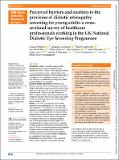Perceived barriers and enablers to the provision of diabetic retinopathy screening for young adults : a cross-sectional survey of healthcare professionals working in the UK National Diabetic Eye Screening Programme
Abstract
Introduction: Diabetic retinopathy screening (DRS) attendance in young adults is consistently below recommended levels. The aim of this study was to conduct a survey of screening providers in the UK Diabetic Eye Screening Programme (DESP) to identify perceived barriers and enablers to DRS attendance in young adults and elicit views on the effectiveness of strategies to improve screening uptake in this population. Research design and methods: Members of the British Association of Retinal Screening (n=580) were invited to complete an anonymous online survey in July 2020 assessing agreement with 37 belief statements, informed by the Theoretical Domains Framework (TDF) of behavior change, describing potential barrier/enablers to delivering DRS for young adults and further survey items exploring effectiveness of strategies to improve uptake of DRS. Results: In total, 140 (24%) responses were received mostly from screener/graders (67.1%). There was a high level of agreement that the DESP had a role in improving attendance in young adults (96.4%) and that more could be done to improve attendance (90.0%). The most commonly reported barriers related to TDF domains Social influences and Environmental context and resources including lack of integration of DRS with other processes of diabetes care, which limited the ability to discuss diabetes self-management. Other barriers included access to screening services and difficulties with scheduling appointments. Less than half (46.4%) of respondents reported having a dedicated strategy to improve screening uptake in young adults. Strategies perceived to be effective included: screening within the community; prompts/reminders and integrating eye screening with other diabetes services. Conclusions: Screening providers were concerned about screening uptake in young adults, although many programs lacked a dedicated strategy to improve attendance. Problems associated with a lack of integration between DRS with other diabetes care processes were identified as a major barrier to providing holistic care to young adults and supporting diabetes self-management.
Citation
EROS Study Investigators , Prothero , L , Lorencatto , F , Cartwright , M , Gardner , P , Anderson , J , Presseau , J , Ivers , N , Grimshaw , J M & Lawrenson , J G 2021 , ' Perceived barriers and enablers to the provision of diabetic retinopathy screening for young adults : a cross-sectional survey of healthcare professionals working in the UK National Diabetic Eye Screening Programme ' , BMJ Open Diabetes Research and Care , vol. 9 , no. 2 , e002436 . https://doi.org/10.1136/bmjdrc-2021-002436
Publication
BMJ Open Diabetes Research and Care
Status
Peer reviewed
ISSN
2052-4897Type
Journal article
Description
Funding: This report is independent research funded by the National Institute for Health Research NIHR Policy Research Program (project reference PR-R20-0318-22001).Collections
Items in the St Andrews Research Repository are protected by copyright, with all rights reserved, unless otherwise indicated.

